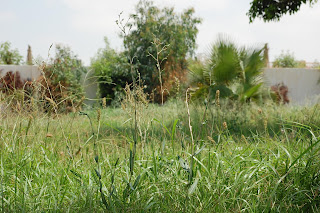The turquoise waters and sandy beaches are the main reasons Cairenes flock to the North Coast in the summer.
There are many things to do here; you can hit the beach or swimming pools and share the waters with the old paunched men in colourful trunks, or relax on the sands, perhaps try to get a tan, and share the sun with their bikini-clad jailbait daughters. Personally, I prefer going for a swim in the most remote part of the beach available, and at an early hour while everyone else is asleep (sleeping hours are from 5am to 5pm on the North Coast, so an early hour could be noon if you wish).
Wild grass growing in an untended garden in a resort - The greenery on the North Coast is mostly grown rather than wild, but is a delight to Cairenes who have been surrounded most of the year by concrete and asphalt.
A view of the Alexandrine Pharos lighthouse replica from within the enclosure of the temple. The high walls have been restored to some degree by the expedition working on the site. The low walls in the foreground are the remains of the Byzantine era Church.
I parked my car at the foot of the hill on which the enclosure was located. I walked out into the glaring sun and looked around. There wasn't anyone around, but a faint rustling from a small makeshift building caught my attention. A small girl with frizzy brown hair peaked out at me from behind the door before running back inside.
Two men came out, one large and burly, sporting a short beard, and the other younger and skinny. I asked them if it was possible to take a look inside and snap a few photos. The larger one asked me suspiciously who I was working for, and I jokingly said I worked for the government. They didn't seem to find it funny. Judging from the accents and demeanor, it was clear they were settled Bedouins. Soon enough though, they found my intention to be pure, and the younger one accompanied me up the hill to guide me. He told me I wasn't allowed to take photos from the inside, but could take a few from outside, and at certain points inside. I asked him why, and he told me that the archaeologists (led by our own Zahi (Not-Again) Hawass and Kathleen Martinez from the Dominican Republic) wouldn't want people taking photos of their 'discoveries' without their permission*.
This section of the wall enclosure shows the various stages of change it has gone through. At the very top is some of the original stone wall as it has been discovered. On the left, the darker stones are some of the early restoration efforts, using local materials. On the right are patches of the lighter stones imported from Giza during recent restoration efforts.
We walked through the temple, and instead of finding squared off archaeology tape, I was surprised to find cigarette butts and soft drink cans lying around the edges. It was a bit better deeper inside though, with piles of ancient pottery shards waiting for examination and classification on display, as well as the well preserved remnants of pylons and columns strewn about. Faint outlines showed different chambers, with my personal guide describing their presumed history. We came onto a deep shaft, where Zahi Hawass got stuck earlier while descending in a faulty device that looked more like a big red birdcage. The device was actually still there. I smiled mischievously as I played out the incident in my head. Apparently they did find something in the shaft; two skeletons and a few gold items.
There are rumors going about that Queen Cleopatra and her lover Mark Anthony may be buried at Taposiris Magna. It is speculated that they were likely to be buried in a deep shaft like the one Zahi got stuck in. Although their tomb hasn't been found, a bust of Cleopatra as well as a few gold coins with her face on it were found. Looking back at the place, it seems like there's a lot of ground still to be uncovered, even though they have been working at it since 2005. Just two months ago, a man-sized headless statue of Ptolemy IV was discovered there - It made me wonder why it took five years to discover it. Every layer that they dig up however contains a new set of discoveries, and judging by the ground I trod on, as well as the large holes that have been excavated, I know there's still a lot more work to be done. Perhaps some day they will find Cleopatra and her lover.
*Without wanting to seem rude, I'm not a really big fan of Zahi Hawass, the Egyptian 'Master' Archaeologist. I believe he's got too much of his nose dug into Egypt's ancient past, with his face plastered across every new discovery. There's also his tendency to explain how he does all that he does for 'Egypt', but somehow most Egyptians are extremely uninformed of Egypt's history, let alone daily discoveries, with most expeditions representing experts from outside of Egypt, and a general lack of education and skill in the field locally. I'm not saying he's incapable - I'm just saying I'd rather see more faces describing Egypt's discoveries, with a more communal rather than monopolizing approach to our history.





No comments:
Post a Comment